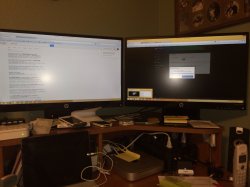I'm looking at a Mac Mini 2012 to replace my Mid 2010 Mac Mini with the 2.4 Core 2 duo. I like the mini for my setup with Dual HP 23BW monitors. However when using VM Fusion the speed drops dramatically.
That's usually a RAM and CPU related problem, especially on older hardware with less upgrade options and dual core processors.
I don't do any video editing but do have a large iTunes library.
A fast cache system is necessary, such as enough RAM, so that OS X and iTunes can load the file system information and file system data in the RAM (cache). RAM is much faster than even the fastest SSD.
I do most of the "heavy lifting" multiple safari windows active with Word, Excel open at the same time with iTunes playing.
iTunes needs ≈ 1-5 % CPU time of a single core.
So I'm looking at 4 total users where I'd like to use Server to share the iTunes library. My thinking is a 2.6 quad core would more than do the job but would the dual core or 2.3 quad be just fine?
OS X and many applications use parallel processing (via Grand Central Dispatch (GCD)) wherever possible. That means OS X uses as many processor cores as possible. VMware Fusion requires also additional (physical) processor cores.
One other thing I'd be taking the 8GB from the 2010 and swapping it into 2012.
That's a bad idea. The RAM is slower than 1600 MHz (Ivy Bridge standard), and reduces therefore the performance of the integrated GPU. The 2012 Mac mini has a much faster iGPU than your Core2Duo Mac mini, which requires also much faster RAM for the best possible performance.
That's what the OS Terminal application said to me last night.

That's an example for an ideal machine for your applications:
-----
- Quad-Core i7 2.3 GHz processor (Ivy Bridge)
-> Why? -> 2.6 GHz means around 10 % better performance. Not noticeable in your office applications, including VMware. Quad-Core processors are the optimal solution for a modern OS (newer versions of OS X, Windows and Linux) and applications which require physical processor cores, like VMware Fusion. Give your virtual machines never more than <= 2 processor core(s) on a Quad-Core machine. OS X needs at least 2 free processor cores for the best possible performance.
-----
- 16 GB RAM (not from Apple; from Crucial or Kingston)
-> Why? -> Apple RAM is expensive. Buy the lowest possible RAM configuration, and then use reliable upgrade options like Crucial RAM or Kingston RAM! You can find the compatible RAM modules via the RAM advisor tools on the manufacturer websites:
http://www.crucial.com/store/advisor.aspx
and
http://www.kingston.com/us/memory/system_specific/desktop_notebook
If possible use 1.35 V RAM and not 1.5 V RAM, because the 1.35 V RAM generates less heat. Both voltages are compatible with Ivy Bridge i7 processors.
OS X can use more RAM for file system caches
and for the integrated GPU (iGPU), if you have enough free RAM. This increases the speed of the OS, of the applications and of the GUI (graphical user interface). 16 GB allows you to give a Windows 7 VM (for example) 4 GB RAM.
-----
- Apple Fusion drive. This (virtual) drive contains a HDD and a SSD. OS X uses the SSD automatically for often accessed data, and optimizes the performance of the SSD via the TRIM command (this increases the long term performance). Apple uses reliable Samsung SSDs. The HDD contains all other data.


